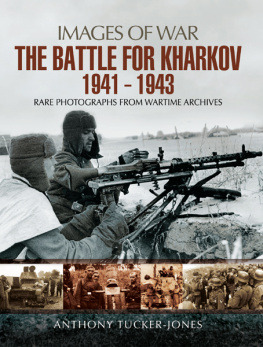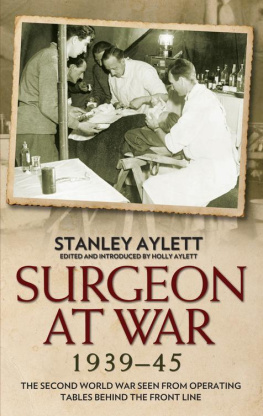First published in Great Britain in 1997 by
LEO COOPER
an imprint of
Pen & Sword Books Ltd
47 Church Street
Barnsley
South Yorkshire
S70 2AS
Anthony Babington, 1997
ISBN 0 85052 562 4
A catalogue record for this book is
available from the British Library
Typeset by Phoenix Typesetting, Ilkley, West Yorkshire
Printed in England by Redwood Books, Trowbridge, Wiltshire
Survivors
No doubt theyll soon get well; the shock and strain
Have caused their stammering, disconnected talk.
Of course theyre longing to go out again,
These boys with old, scared faces, learning to walk.
Theyll soon forget their haunted nights; their cowed
Subjection to the ghosts of friends who died,
Their dreams that drip with murder; and theyll be proud
Of glorious war that shatterd all their pride
Men who went out to battle, grim and glad;
Children, with eyes that hate you, broken and mad.
Siegfried Sassoon
Craiglockhart
October, 1917
Foreword
This is not a medical book. I am neither a doctor nor a psychologist. The book is essentially concerned with the adversities of ordinary soldiers what was expected of them, what they endured and what happened to them after they had reached the limits of their fortitude.
For many years it was believed that soldiers on campaign were prone to certain strange, endemic maladies. These were given various names and were attributed to various causes. It was only fairly recently that it was realized that most of the disorders had a psychiatric origin.
I first encountered war neurosis while I was serving as an infantry officer during the Second World War and I saw men breaking down on the battlefield. Years later I was writing a book about capital courts martial in the 19141918 war and the Ministry of Defence granted me privileged access to the files relating to the trials of the condemned soldiers. On reading the evidence, I became convinced that some of the men had been suffering from what in those days was called shell-shock when they had committed the derelictions of duty for which they were executed. It was then I made up my mind that some day I would write a history of war neurosis and all of the misconceptions which had surrounded it in the past.
I should like to express my immense gratitude to my friend Robin Price, Librarian of The Wellcome Institute For The History Of Medicine, for the help and encouragement he gave me when I was carrying out my research, and to Claire Nutt, one of his assistants, who always managed to find for me the authorities I wished to read. I want, also, to mention my appreciation of the unfailing kindness which was shown to me by all the members of the staff at the Institutes library.
I am grateful as well to Tony McSen, the Librarian of the British Medical Association, and to Judithe Blacklaw, Librarian at the Whitehall Library of the Ministry of Defence, for supplying the photocopies of articles and documents which I required.
Finally, I wish to thank my niece Sally La Niece, for managing to read my handwriting and for preparing my manuscript for the publishers.
Anthony Babington
Chapter 1
On 12 March, 1915, Lance-Sergeant Walton, a 26-year-old soldier in the British Regular Army, was court-martialled for desertion. He was serving in the 2nd Battalion of the Kings Royal Rifle Corps and in the middle of the previous August he had been among the first troops to arrive in France with the original British Expeditionary Force. His Division had engaged the leading formations of the advancing German Army outside the Belgian town of Mons on 22 August, and during the days that followed they had taken part in the arduous retreat which had continued without a pause until the Allies had managed to establish a defensive line to the south-east of Paris on 5 September. By then the BEF had trudged a distance of nearly two hundred miles, continuously harried by the enemy and suffering very heavy casualties. In the words of the Official History of the campaign, they had been condemned at the very outset to undergo the severest ordeal which can be imposed on any army.
Throughout the month of September the depleted Divisions of the BEF had been in constant action. At the beginning of October they had been moved from their positions east of Paris to take over the left sector of the Allied line, stretching southwards from the Channel Ports. From there they had immediately launched an offensive across the Flanders Plain in what became known as the First Battle of Ypres. Sergeant Waltons battalion was once again in the thick of the fighting.
On 29 October, when the BEF had been in hastily-prepared defensive positions round Ypres, the Germans had launched a massive attack on the town. Waltons Division was guarding the approaches to Gheluvelt, a strategically-important village on the road from Menin to Ypres, and had borne the brunt of the assault. The bitter struggle had lasted for four days during which Gheluvelt had changed hands three times. Eventually the British, heavily outnumbered and outgunned, had been forced to withdraw to a new line. All the battalions which had taken part in the action had suffered severe casualties.
At this stage, the Official History commented, the British Army was composed of tired, haggard and unshaven men, unwashed, plastered with mud, many in little more than rags.
The charge against Lance-Sergeant Walton was that he had deserted near Ypres between the 1st and 9th November 1914, and that he had stayed at liberty until he was arrested by a French gendarme in a private house at Arques on 3 March, 1915. The details of his court martial are still retained in the Public Record Office at Kew. He was tried by three officers, a Major, a Captain and a Lieutenant, and it is not disclosed whether or not he was represented by what was termed a prisoners friend. Usually a soldier on trial asked his platoon commander or his company commander to defend him.
The first witness for the prosecution was a sergeant from Waltons own battalion, who had seen him on duty with his company on 1 November and had heard later that he had been wounded and evacuated to hospital. The sergeant added at the end of his evidence that the battalion had been in action on the 1st and 2nd of November and had sustained heavy casualties on both days. On 9 November Walton had been reported missing.
A crucial prosecution witness was a French civilian, a cobbler from Arques, a small village a few miles south of St Omer and about twenty-five miles from Ypres, who had first seen Walton in the vicinity of his house on the evening of 18 December. Walton was then without any arms or equipment; he looked cold and wet, had a bad cough and appeared to have been wounded in his left hand. The cobbler had taken sympathy on him and invited him to come in for a while and get warm by the fire. Walton had agreed to this proposal. Later he had asked if he could be put up for the night. The cobbler only had one bed in his home but he told Walton that he did not mind sharing it with him. The arrangement had, in fact, continued for over two months. During this time, the cobbler said in his evidence, Walton had never tried to hide; he had drawn his rations from a neighbouring depot and he had frequently chatted to other British soldiers who happened to be in the village. Apart from one absence of five days, Walton had remained at the house until the day of his apprehension.
A gendarme gave formal evidence that, on 3 March, 1915, following a tip-off, he had visited the cobblers house in Arques. He had found Walton there, wearing army uniform khaki trousers and a civilian jersey. The gendarme had arrested him as a suspected deserter.










